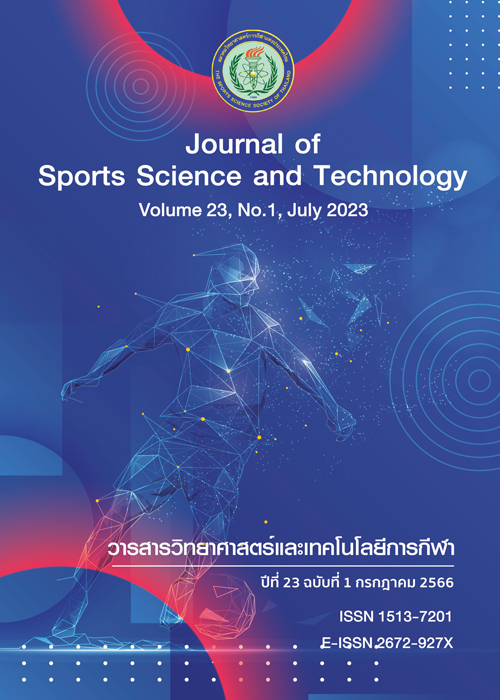THE DEVELOPMENT THE THAI VERSION OF THE ATHLETE MINDFULNESS QUESTIONNAIRE
DOI:
https://doi.org/10.14456/jsst.2023.5Keywords:
Mindfulness, individual athletes, Team athletesAbstract
To develop a Thai version of the Mindfulness in Athlete Questionnaire and use it to compare mindfulness differences between team and individual athletes participating in the Thai University Games.The researcher used the back translation method to translate Chun-Qing Zhang's mindfulness questionnaire to determine the reliability of the questionnaire according to Cronbach's alpha reliability method. The sample consisted of 30 athletes and team and individual athletes who participated in the 47th University Games of Thailand, a total of 155 people, consisting of 99 (63.9%) males and 56(36.1%), females with an average age of 20.9 ± 1.8 years, were 108 (69.7%) team athletes and 47 (30.3%) individual athletes.
The confidence level of all 16 questionnaires was 0.89, indicating that the questionnaires were consistent. When divided into the present-moment attention and the awareness, it was found to be greater than 0.71, corresponding to 0.77 and 0.80, respectively. The acceptance aspect was less than 0.71, corresponding to 0.68, since the question in item 16 had a distribution of only 0.22. If item 16 was removed, the confidence was increased to 7.18 and the questionnaire's confidence for all 15 items was 0.88 when the questionnaire was used to assess differences between groups of teams and individual athletes. It was found that the mean scores of teams and individual athletes were not statistically different. Team athletes had higher average scores than individual athletes in all three aspects. The Thai version of the questionnaire on mindfulness in athletes. The confidence value is in the range of excellent criteria. This questionnaire contains 15 questions, that can be used to assess the mindfulness level of general athletes, and when studying the differences between team and individual athletes. It was found that there was no difference in all 3 aspects.
(Journal of Sports Science and Technology 2023; 23(1):66-76)
(Received: 28 December 2022, Revised: 27 March 2023, Accepted: 31 March 2023)
Keyword: Mindfulness / individual athletes/ Team athletes
*Corresponding author: Phavadol RAKTAVEE
Department of Sport Science, Faculty of Physical Education,
Srinakharinwirot University, THAILAND.
e-mail: spphavadol@gmail.com
References
Williams JMG, Kabat-Zinn J. Mindfulness: diverse perspectives on its meaning, origins, and multiple applications at the intersection of science and dharma. Contemp. Buddhism. 2011;12(1):1-18.
Kabat-Zinn J. Full Catastrophe Living: Using the Wisdom of Your Body and Mind to Face Stress, Pain, and Illness. New York: Delacourt; 2013.
Kachanathu S, Verma S, Khanna G. The effect of music therapy and meditation on sports performance in professional shooters. Int J Res Ayurveda Pharm. 2012;3:133-6.
Singhnoy C, lu f, Vongjaturapat N, Noiphol S. Translation and Factorial Validation of The Mindfulness Inventory for Sport in Thai Version (MISt). J Sports Sci Technol. 2020;20(2):67-80.
Olendzki A. Mindfulness and Meditation. 2009. p. 37-44.
Rattana T. What is mindfulness? Like meditation? 2023 [cited 2023 09/02/2018]. Available from: https://faithandbacon.com/what-is-mindfulness/.
Olendzki A. Mindfulness and Meditation. 2009. p. 37-44.
Wisuthisaro PM. Meditation and mindfulness and depression 2015 [cited 2023 02/05/23]. Available from: https://www.gotoknow.org/posts/589331.
Brown KW, Ryan RM, Creswell JD. Mindfulness: Theoretical Foundations and Evidence for its Salutary Effects. Psychol Inq. 2007;18(4):211-37.
Brown KW, Ryan RM. The benefits of being present: mindfulness and its role in psychological well-being. J Abnorm Soc Psychol. 2003;84(4):822-48.
Panuwatsuk P. Meditation 2015 [cited 2018 09/12/2018]. Available from: https://www.novabizz.com/NovaAce/Spiritual/Meditation.htm.
Collins MP, Dunn LF. The effects of meditation and visual imagery on an immune system disorder: Dermatomyositis. J Altern Complem Med. 2005;11(2):275-84.
Korkiatpitak K. Effects of Tai Chi Chuan meditation training on the attack accuracy to target thrusing of Foil and Epee. Journal of Education Prince of Songkla University. 2016;27:131-42.
Mascaro JS, Rilling JK, Negi LT, Raison CL. Pre-existing brain function predicts subsequent practice of mindfulness and compassion meditation. Neuroimage. 2013;69:35-42.
Jain S, Shapiro SL, Swanick S, Roesch SC, Mills PJ, Bell I, et al. A randomized controlled trial of mindfulness meditation versus relaxation training: Effects on distress, positive states of mind, rumination, and distraction. Ann Behav Med. 2007;33(1):11-21.
Manotas M, Segura C, Eraso M, Oggins J, McGovern K. Association of Brief Mindfulness Training With Reductions in Perceived Stress and Distress in Colombian Health Care Professionals. Int J Stress Manage. 2014;21(2):207-25.
Lavretsky H, Epel ES, Siddarth P, Nazarian N, Cyr NS, Khalsa DS, et al. A pilot study of yogic meditation for family dementia caregivers with depressive symptoms: effects on mental health, cognition, and telomerase activity. Int J Geriatr Psychiatry. 2013;28(1):57-65.
Hall CR, Rodgers WM, Wilson PM, Norman P. Imagery Use and Self-Determined Motivations in a Community Sample of Exercisers and Non-Exercisers. J Appl Soc Psychol. 2010;40(1):135-52.
Beazley H, Bessell L, Ennew J, Waterson R. Comparative research on physical and emotional punishment of children in Southeast Asia and the Pacific: Regional protocol. 2011.
Zhang CQ, Chung PK, Si G. Assessing acceptance in mindfulness with direct-worded items: The development and initial validation of the Athlete Mindfulness Questionnaire. J Sport Health Sci. 2017;6(3):311-20.
KC. JF. Measures for clinical practice: A sourcebook: New York Free Press; 1994.
R. Dunn B, Hartigan JA, L. Mikulas W. Concentration and Mindfulness Meditations: Unique Forms of Consciousness?1999. 147-65 p.
kroobannok.com. Meditation 2008 [Available from: https://www.kroobannok.com/2304.
Baltzell A, Caraballo N, Chipman K, Hayden L. A Qualitative Study of the Mindfulness Meditation Training for Sport: Division I Female Soccer Players’ Experience2014. 221-44 p.






